FEMUSINDO.com - In the beliefs and mythology of the Ancient Greeks, Muses are goddesses who inspire humans to create works in the fields of literature, science, and art.
Muses are the children of Zeus and Mnemosyne. Muses were born after Zeus slept with Mnemosyne for nine consecutive nights.
They are identical to the goddesses of music, song, and dance. Their music can bring happiness to those who hear it. Each Muse has their own specialty.
These goddesses are considered to be the source of knowledge that is embodied in poetry, lyre songs, and myths that have been spoken from century to century within the scope of Ancient Greek culture.
At first, the number and names of Muses varied from region to region. Since classical times, the number of Muses has been standardized at nine.
The names of the Muses that commonly appear in descriptions include Kaliope, Kleyo, Polyhymnia, Euterpe, Terpsichore, Erato, Melpomene, Talia, and Urania.
In modern times, muse has become a word used to describe people or supernatural powers that inspire the creation of works of art.
The names of the Muses and their specialties include Kaliope (heroic poetry), Kleyo (history), Erato (love poetry), Euterpe (poetry), Melpomene (tragedy), Polyhymnia (sacred poetry), Terpsichore (choir and dance), Talia (comedy) and Urania (astronomy).
These nine goddesses in Greek mythology have extraordinary artistic talents. Until now, the Muses have become the personification of various arts, such as music, dance and poetry to artistic. (*)
.png)




No comments:
Write comment